Improvement in Spatiotemporal Chl-a Data in the South China Sea Using the Random-Forest-Based Geo-Imputation Method and Ocean Dynamics Data
Abstract
1. Introduction
2. Materials and Methods
2.1. Study Area and Data
2.2. Methodology
2.2.1. Methods for Predicting Chl-a
Multilayer Perceptron
Random Forests
Gradient Boosted Decision Trees
K-Nearest Neighbor
2.2.2. Regression Model Accuracy Metrics
2.2.3. Determination of Explanatory Variables
2.2.4. Cross-Validation and Parameter Tuning
3. Results
3.1. Estimation of the Total Missing in the Chl-a Data across the SCS
3.2. Accuracy Evaluation of Imputation Based on Month
3.3. Accuracy Evaluation of Imputation Based on Missing Ratio
3.4. Comparison of Spatial Imputation Based on Month and Based on Missing Ratio
4. Discussion
5. Conclusions
- (1)
- Among the models employing the monthly prediction approach, the RF model consistently demonstrated the highest prediction accuracy, followed by GBDT and KNN, with the MLP performing the least favorably. The RF model excels in both prediction accuracy and the distribution of model residuals when compared to the other models.
- (2)
- In the case of models employing the missing ratio approach, the RF model again emerged as the most accurate, followed by GBDT and MLP, while KNN lagged behind with a comparatively poorer combined performance. It is important to note that the overall prediction accuracy decreased as the data’s missing ratio increased.
- (3)
- Irrespective of the prediction approach, the RF model consistently delivered a superior performance. When comparing the two prediction methods within the RF model using 2018 data, it became apparent that increasing the missing data ratios negatively impacted the accuracy of the monthly prediction approach. In general, the results obtained through the monthly prediction approach exhibited a better overall accuracy, more stable residual variances, and superior generalization capabilities compared to the missing ratio prediction approach.
Author Contributions
Funding
Institutional Review Board Statement
Informed Consent Statement
Data Availability Statement
Acknowledgments
Conflicts of Interest
References
- Donders, A.; van der Heijden, G.; Stijnen, T.; Moons, K. Review: A gentle introduction to imputation of missing values. J. Clin. Epidemiol. 2006, 59, 1087–1109. [Google Scholar] [CrossRef]
- Dakos, V.; Matthews, B.; Hendry, A.; Levine, J.; Loeuille, N.; Norberg, J.; Nosil, P.; Scheffer, M.; Meester, L. Ecosystem tipping points in an evolving world. Nat. Ecol. Evol. 2019, 3, 355–362. [Google Scholar] [CrossRef]
- Wang, F.; Li, X.; Tang, X.; Sun, X.; Zhang, J.; Yang, D.; Xu, L.; Zhang, H.; Yuan, H.; Wang, Y. The seas around China in a warming climate. Nat. Rev. Earth Environ. 2023, 4, 535–551. [Google Scholar] [CrossRef]
- Kajiyama, T.; D’Alimonte, D.; Cunha, J. Performance prediction of ocean color Monte Carlo simulations using multi-layer perceptron neural networks. Pro. Com. Sci. 2011, 4, 2186–2195. [Google Scholar] [CrossRef][Green Version]
- Amorim, F.; Rick, J.; Lohmann, G.; Wiltshire, K. Evaluation of Machine Learning Predictions of a Highly Resolved Time Series of Chlorophyll-a Concentration. Appl. Sci. 2021, 11, 7208. [Google Scholar] [CrossRef]
- Jin, D.; Lee, E.; Kwon, K.; Kim, T. Deep Learning Model Using Satellite Ocean Color and Hydrodynamic Model to Estimate Chlorophyll-a Concentration. Remote Sens. 2021, 13, 2003. [Google Scholar] [CrossRef]
- Im, G.; Lee, D.; Lee, S.; Lee, J.; Lee, S.; Park, J.; Heo, T. Estimating Chlorophyll-a Concentration from Hyperspectral Data Using Various Machine Learning Techniques: A Case Study at Paldang Dam, Republic of Korea. Water 2022, 14, 4080. [Google Scholar] [CrossRef]
- González-Enrique, J.; Ruiz-Aguilar, J.; Madrid Navarro, E.; Martínez Álvarez-Castellanos, R.; Felis Enguix, I.; Jerez, J.; Turias, I. Deep Learning Approach for the Prediction of the Concentration of Chlorophyll a in Seawater. A Case Study in El Mar Menor (Spain). In Proceedings of the 17th International Conference on Soft Computing Models in Industrial and Environmental Applications (SOCO 2022): Lecture Notes in Networks and Systems, Salamanca, Spain, 5–7 September 2022; pp. 72–85. [Google Scholar]
- Liu, M.; Liu, X.; Ma, A.; Li, T.; Du, Z. Spatio-temporal stability and abnormality of chlorophyll-a in the northern south china sea during 2002–2012 from modis images using wavelet analysis. Cont. Shelf. Res. 2014, 75, 15–27. [Google Scholar] [CrossRef]
- Kutser, T. Passive optical remote sensing of cyanobacteria and other intense phytoplankton blooms in coastal and inland waters. Int. J. Remote Sens. 2009, 30, 4401–4425. [Google Scholar] [CrossRef]
- Kown, Y.; Baek, S.; Lim, Y.; Pyo, J.; Ligaray, M.; Park, Y.; Cho, K. Monitoring Coastal Chlorophyll-a Concentrations in Coastal Areas Using Machine Learning Models. Water 2018, 10, 1020. [Google Scholar] [CrossRef]
- Watanabe, F.; Alcntara, E.; Rodrigues, T.; Rotta, L.; Bernardo, N.; Imai, N. Remote sensing of the chlorophyll-a based on OLI/Landsat-8 and MSI/Sentinel-2A (Barra Bonita reservoir, Brazil). An. Da Acad. Bras. De Ciências 2018, 90, 1987–2000. [Google Scholar] [CrossRef]
- Mattei, F.; Scardi, M. Mining satellite data for extracting chlorophyll a spatio-temporal patterns in the Mediterranean Sea. Environ. Modell. Softw. 2022, 150, 105353. [Google Scholar] [CrossRef]
- Mohebzadeh, H.; Mokari, E.; Daggupati, P.; Biswas, A. A machine learning approach for spatiotemporal imputation of MODIS chlorophyll-a. Int. J. Remote Sens. 2021, 42, 7381–7740. [Google Scholar] [CrossRef]
- Wang, S.; Li, W.; Hou, S.; Guan, J.; Yao, J. STA-GAN: A Spatio-Temporal Attention Generative Adversarial Network for Missing Value Imputation in Satellite Data. Remote Sens. 2022, 15, 88. [Google Scholar] [CrossRef]
- Chen, S.; Hu, C.; Barnes, B.; Xie, Y.; Lin, G.; Qiu, Z. Improving ocean color data coverage through machine learning. Remote Sens. Environ. 2019, 222, 286–302. [Google Scholar] [CrossRef]
- Yu, P.; Gao, R.; Zhang, D.; Liu, Z. Predicting coastal algal blooms with environmental factors by machine learning methods. Ecol. Indic. 2021, 12, 107334. [Google Scholar] [CrossRef]
- Kim, W.; Cho, W.; Choi, J.; Kim, J.; Park, C.; Choo, J. A Comparison of the Effects of Data Imputation Methods on Model Performance. In Proceedings of the International Conference on Advanced Communications Technology, PyeongChang, Republic of Korea, 17–20 February 2019; pp. 592–599. [Google Scholar]
- Wongoutong, C. Imputation Methods in Time Series with a Trend and a consecutive missing value pattern. Thail. Statist. 2021, 19, 866–879. [Google Scholar]
- Janik, M.; Bossew, P.; Kurihara, O. Machine learning methods as a tool to analyse incomplete or irregularly sampled radon time series data. Sci. Total Environ. 2018, 630, 1155–1167. [Google Scholar] [CrossRef]
- Kim, J.; Shin, J.; Lee, H.; Lee, D.; Kang, J.; Cho, K.; Lee, Y.; Chon, K.; Baek, S.; Park, Y. Improving the performance of machine learning models for early warning of harmful algal blooms using an adaptive synthetic sampling method. Water Res. 2021, 207, 11782. [Google Scholar] [CrossRef]
- He, Q.; Wang, M.; Liu, K. Spatial interpolation of temperature elements based on machine learning. Plateau Meteorol. (Chin.) 2022, 41, 16. [Google Scholar]
- Poloczek, J.; Treiber, N.; Kramer, O. KNN Regression as Geo-Imputation Method for Spatio-Temporal Wind Data. In Proceedings of the International Joint Conference SOCO’14-CISIS’14-ICEUTE’14, Bilbao, Spain, 25–27 June 2014; pp. 185–193. [Google Scholar]
- Thomas, T.; Rajabi, E. A systematic review of machine learning-based missing value imputation techniques. Data Technol. Appl. 2021, 55, 558–585. [Google Scholar] [CrossRef]
- Kim, H.; Soh, H.; Kwak, M.; Han, S. Machine Learning and Multiple Imputation Approach to Predict Chlorophyll-a Concentration in the Coastal Zone of Korea. Water 2022, 14, 1862. [Google Scholar] [CrossRef]
- Lin, J.; Liu, Q.; Song, Y.; Liu, J.; Yin, Y.; Hall, N. Temporal Prediction of Coastal Water Quality Based on Environmental Factors with Machine Learning. J. Mar. Sci. Eng. 2023, 11, 1608. [Google Scholar] [CrossRef]
- Jerez, J.; Molina, I.; García-Laencina, P.; Alba, E.; Ribelles, N.; Martín, M.; Franco, L. Missing data imputation using statistical and machine learning methods in a real breast cancer problem. Artif. Intell. Med. 2010, 50, 105–115. [Google Scholar] [CrossRef]
- Nunes Carvalho, T.; Lima Neto, I.; Souza Filho, F. Uncovering the influence of hydrological and climate variables in chlorophyll-A concentration in tropical reservoirs with machine learning. Environ. Sci. Pollut. Res. 2022, 29, 74967–74982. [Google Scholar] [CrossRef]
- Hu, M.; Wang, Y.; Sun, Z.; Su, Y.; Li, S.; Bao, Y.; Wen, J. Performance of ensemble-learning models for predicting eutrophication in Zhuyi Bay, Three Gorges Reservoir. River Res. Appl. 2020, 37, 1104–1114. [Google Scholar] [CrossRef]
- Shin, Y.; Kim, T.; Hong, S.; Lee, S.; Lee, E.; Hong, S.; Lee, C.; Kim, T.; Park, M.S.; Park, J. Prediction of Chlorophyll-a Concentrations in the Nakdong River Using Machine Learning Methods. Water 2020, 12, 1822. [Google Scholar] [CrossRef]
- Feng, L.; Nowak, G.; O’Neill, T.; Welsh, A. CUTOFF: A spatio-temporal imputation method. J. Hydrol. 2014, 519, 3591–3605. [Google Scholar] [CrossRef]
- Sathyendranath, S.; Brewin, R.; Brockmann, C.; Brotas, V.; Calton, B.; Chuprin, A.; Cipollini, P.; Couto, A.; Dingle, J.; Doerffer, R. An Ocean-Colour Time Series for Use in Climate Studies: The Experience of the Ocean-Colour Climate Change Initiative (OC-CCI). Sensors 2019, 19, 4285. [Google Scholar] [CrossRef]
- Dee, D.; Uppala, S.; Simmons, A.; Berrisford, P.; Poli, P.; Kobayashi, S.; Andrae, U.; Balmaseda, M.; Balsamo, G.; Bauer, P. The ERA-Interim reanalysis: Configuration and performance of the data assimilation system. Q. J. Roy. Meteor. Soc. 2011, 137, 553–597. [Google Scholar] [CrossRef]
- Belgiu, M.; Drăguţ, L. Random forest in remote sensing: A review of applications and future directions. Isprs J. Photogramm. 2016, 114, 24–31. [Google Scholar] [CrossRef]
- Chicco, D.; Warrens, M.; Jurman, G. The coefficient of determination R-squared is more informative than SMAPE, MAE, MAPE, MSE and RMSE in regression analysis evaluation. Peerj Comput. Sci. 2021, 7, e623. [Google Scholar] [CrossRef] [PubMed]
- Lin, P.; Ma, J.; Chai, F.; Xiu, P.; Liu, H. Decadal variability of nutrients and biomass in the southern region of Kuroshio Extension. Prog. Oceanogr. 2020, 188, 102441. [Google Scholar] [CrossRef]
- Yu, Y.; Wang, Y.; Cao, L.; Tang, R.; Chai, F. The ocean-atmosphere interaction over a summer upwelling system in the South China Sea. J. Mar. Syst. 2020, 208, 103360. [Google Scholar] [CrossRef]
- Xiu, P.; Chai, F. Eddies Affect Subsurface Phytoplankton and Oxygen Distributions in the North Pacific Subtropical Gyre. Geophys. Res. Lett. 2020, 47, e2020GL087037. [Google Scholar] [CrossRef]
- Guo, L.; Xiu, P.; Chai, F.; Xue, H.; Wang, D.; Sun, J. Enhanced Chlorophyll Concentrations Induced by Kuroshio Intrusion Fronts in the Northern South China Sea. Geophys. Res. Lett. 2017, 44, 11–565. [Google Scholar] [CrossRef]
- Guo, M.; Xiu, P.; Li, S.; Chai, F.; Xue, H.; Zhou, K.; Dai, M. Seasonal variability and mechanisms regulating chlorophyll distribution in mesoscale eddies in the South China Sea. J. Geophys. Res.-Ocean. 2017, 122, 5329–5347. [Google Scholar] [CrossRef]
- Palacz, A.P.; Xue, H.; Armbrecht, C.; Zhang, C.; Chai, F. Seasonal and inter-annual changes in the surface chlorophyll of the South China Sea. J. Geophys. Res. 2011, 116, C09015. [Google Scholar] [CrossRef]
- Liu, M.; Liu, X.; Ma, A.; Zhang, B.; Jin, M. Spatiotemporal variability of chlorophyll a and sea surface temperature in the northern south china sea from 2002 to 2012. Can. J. Remote Sens. 2015, 41, 547–560. [Google Scholar] [CrossRef]
- Yu, Y.; Xing, X.; Liu, H.; Yuan, Y.; Wang, Y.; Chai, F. The variability of chlorophyll-a and its relationship with dynamic factors in the basin of the South China Sea. J. Mar. Syst. 2019, 200, 103230. [Google Scholar] [CrossRef]
- Wang, T.; Sun, Y.; Su, H.; Lu, W. Declined trends of chlorophyll a in the South China Sea over 2005–2019 from remote sensing reconstruction. Acta Oceanol. Sin. 2023, 42, 12–24. [Google Scholar] [CrossRef]
- Moorthy, K.; Mohamad, M.; Deris, S. A Review on Missing Value Imputation Algorithms for Microarray Gene Expression Data. Curr. Bioinform. 2014, 9, 18–22. [Google Scholar] [CrossRef]
- Li, A.; Feng, Y.; Wang, Y.; Xue, H. Spatial and temporal changes of water area with high chlorophyll concentration in the South China Sea based on OC-CCI data. J. Trop. Ocean. (Chin.) 2022, 41, 13. [Google Scholar]
- Liu, N.; Chen, S.; Chen, Z.; Wang, X.; Xiao, Y.; Li, X.; Gong, Y.; Wang, T.; Zhang, X.; Liu, S. Long-term prediction of sea surface chlorophyll-a concentration based on the combination of spatio-temporal features. Water Res. 2022, 211, 118040. [Google Scholar]
- Blondeau-Patissier, D.; Gower, J.; Dekker, A.; Phinn, S.; Brando, V. A review of ocean color remote sensing methods and statistical techniques for the detection, mapping and analysis of phytoplankton blooms in coastal and open oceans. Prog. Oceanogr. 2014, 123, 123–144. [Google Scholar] [CrossRef]
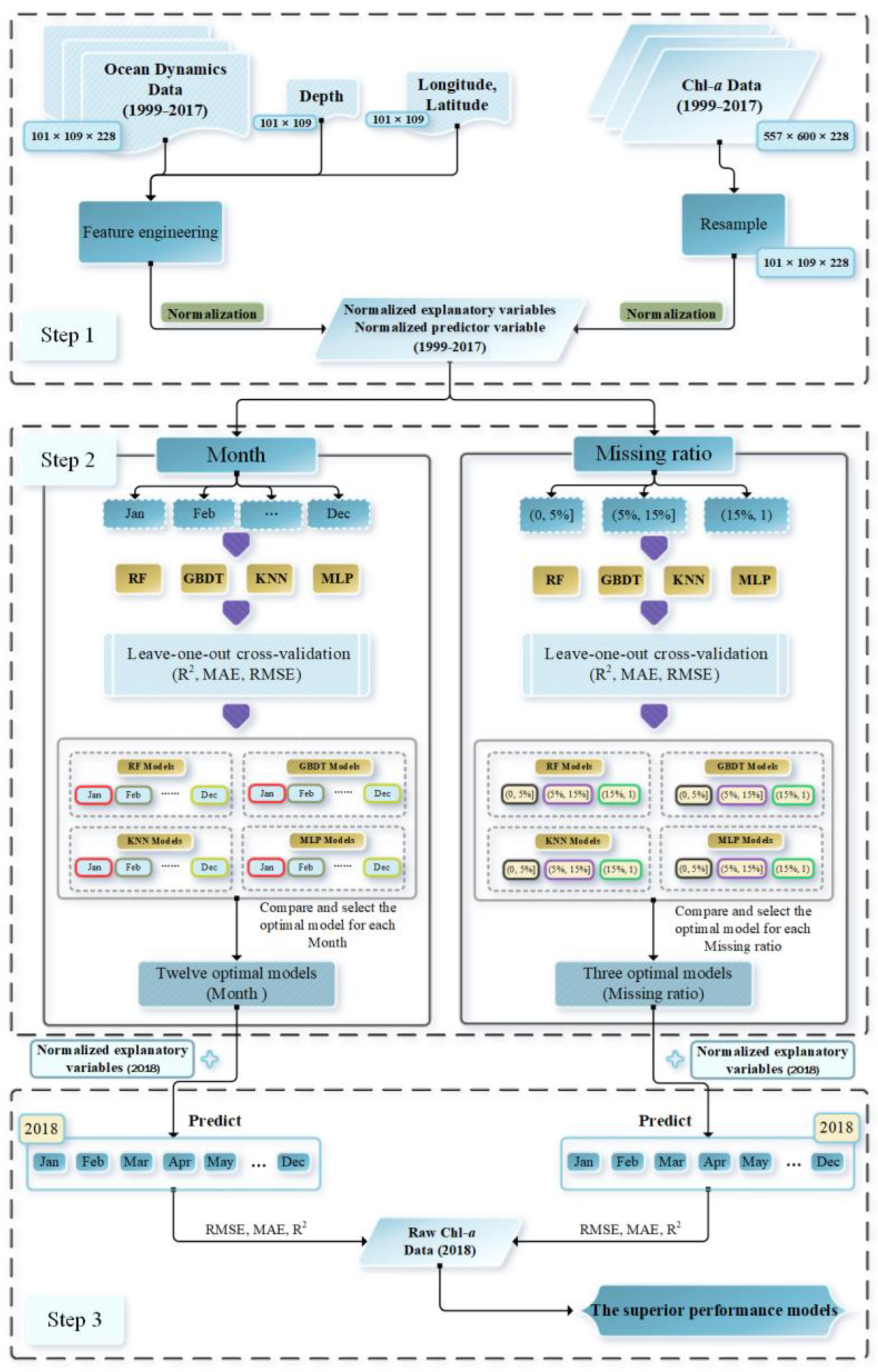

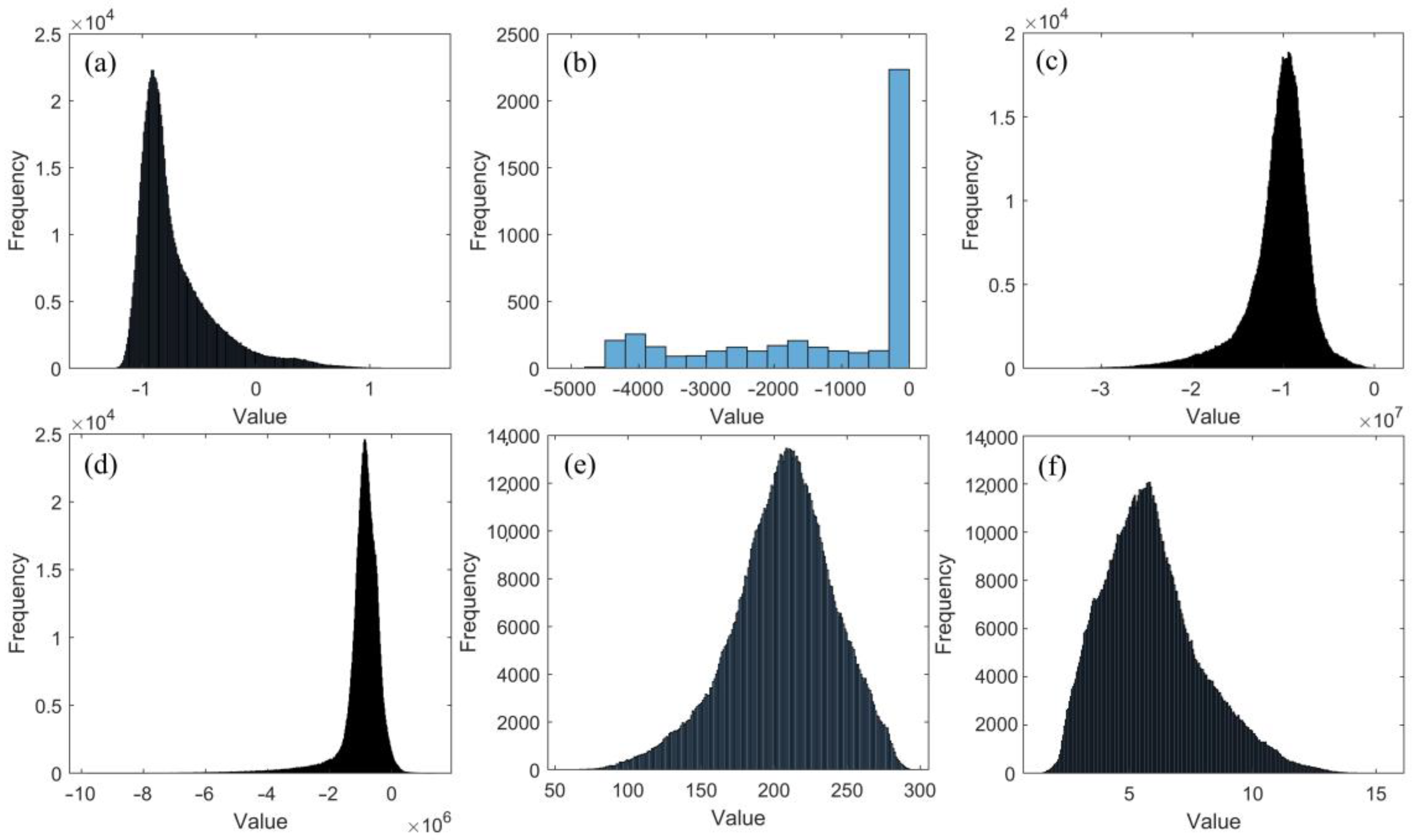


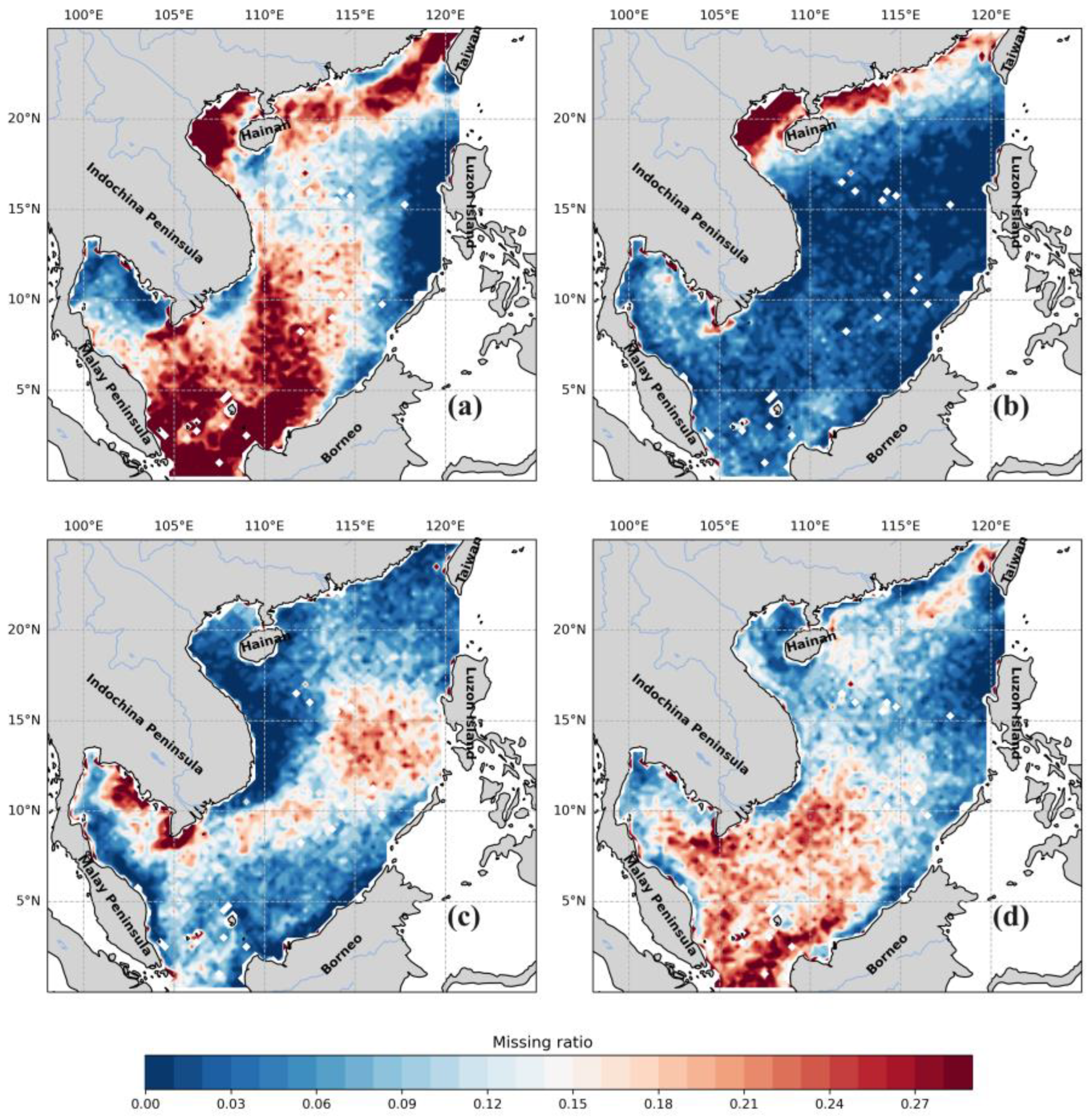
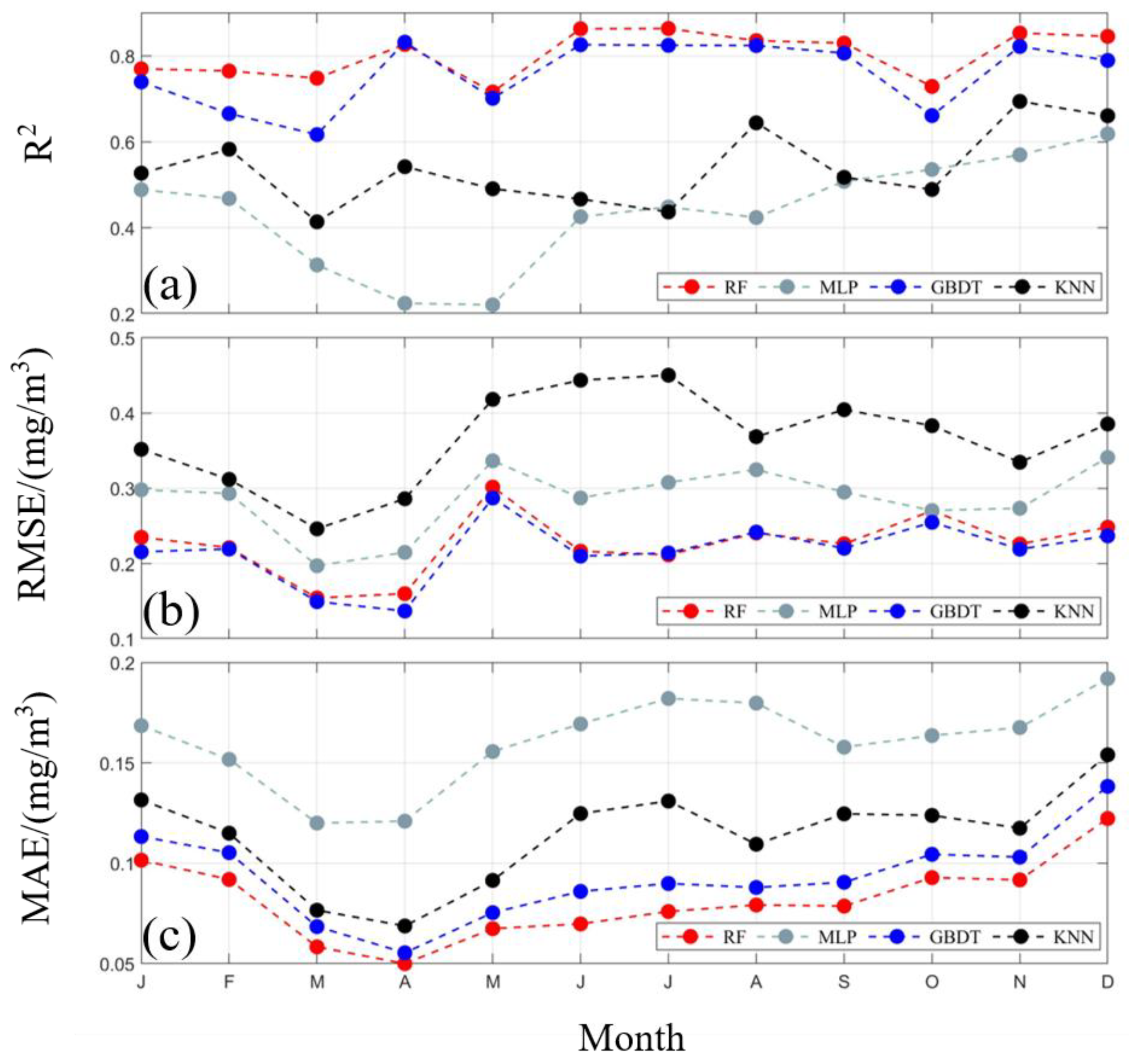
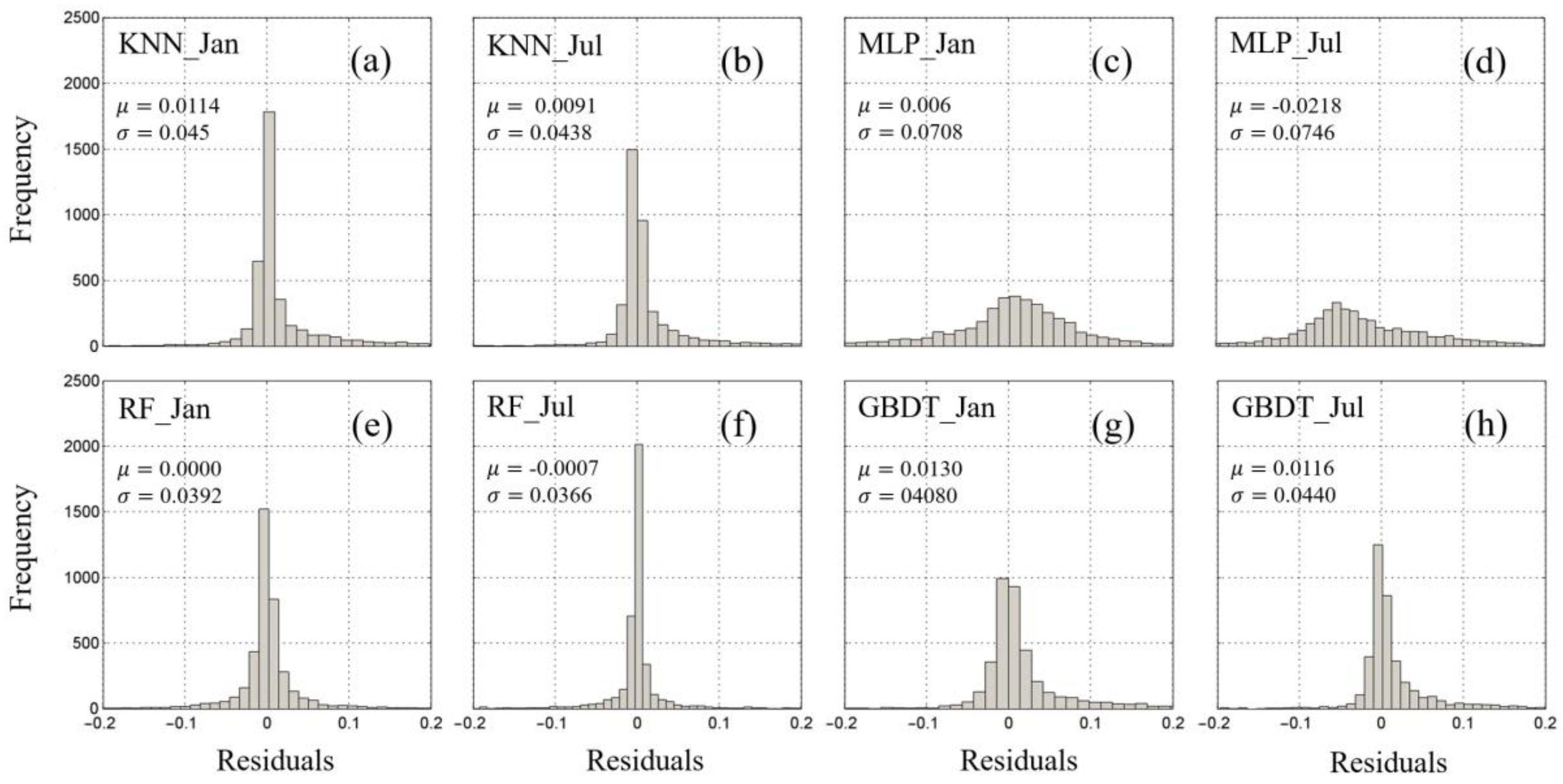

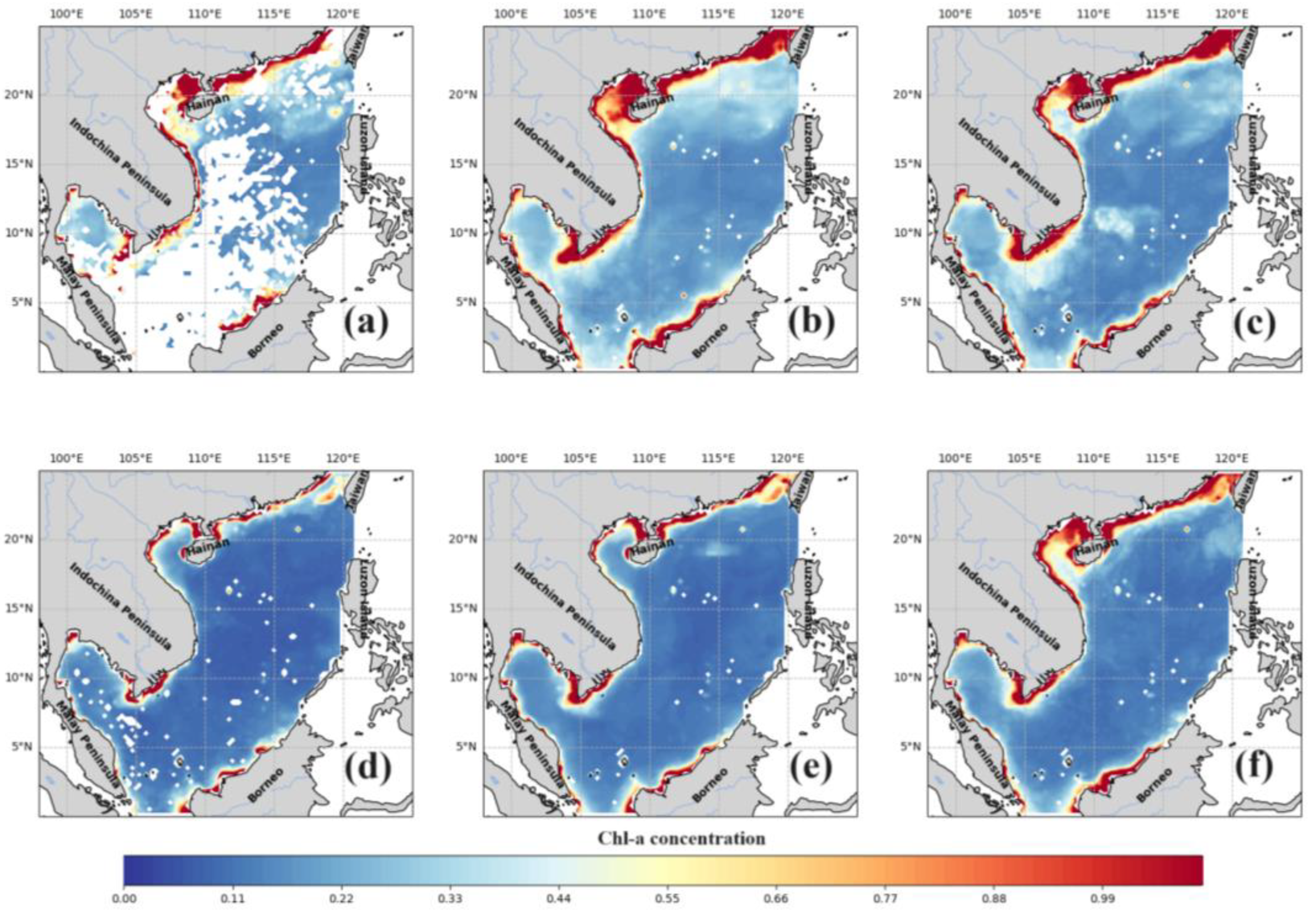
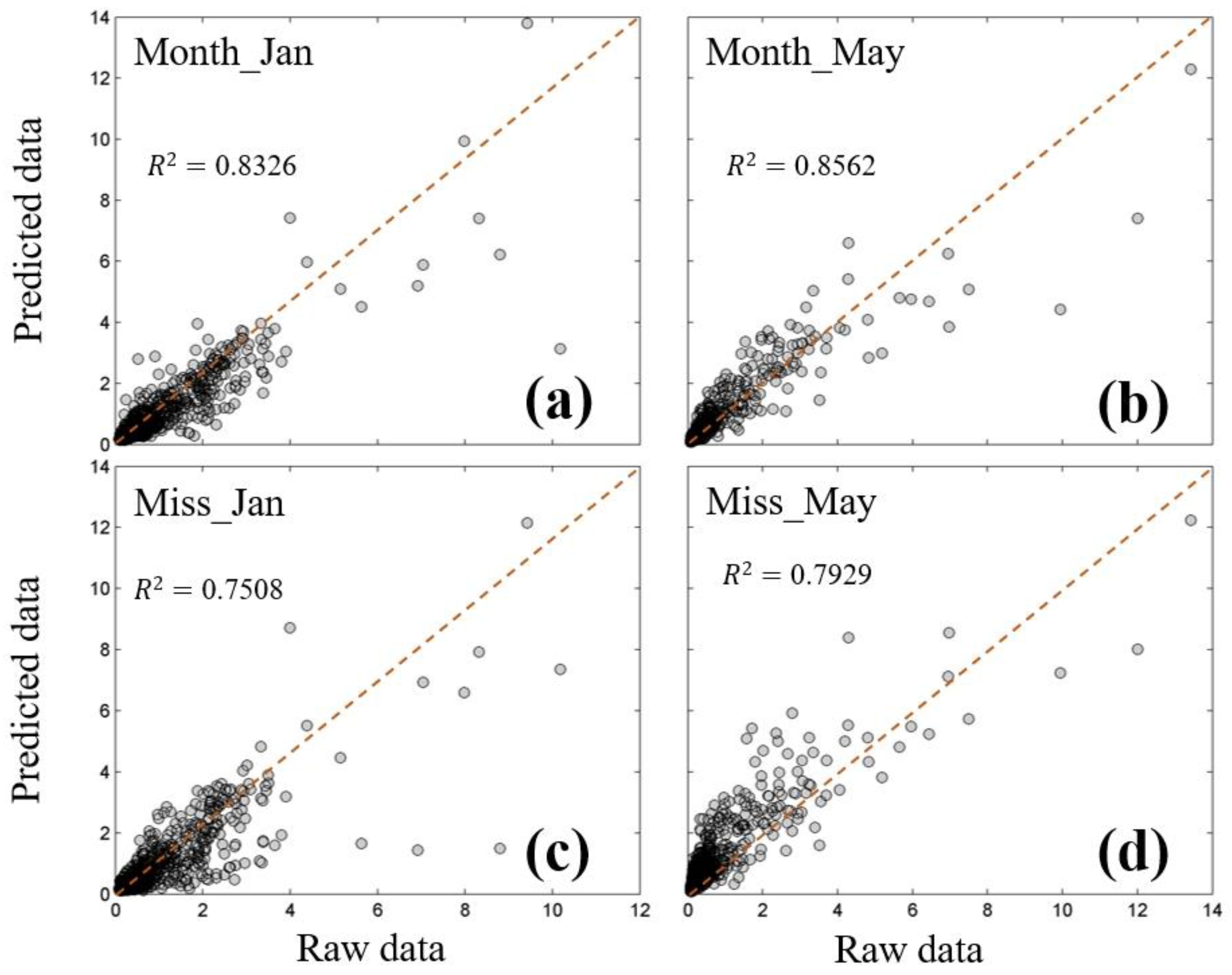

| Dataset | Unit | Min | Max | Spatial Resolution | Grid Size (Pixel) |
|---|---|---|---|---|---|
| Chl-a | mg/m3 | 0 | 26.6 | 0.04° × 0.04° | 557 × 600 × 240 |
| Lon | ° | 99 | 122.5 | 0.25° × 0.25° | 101 × 109 |
| Lat | ° | 0 | 23.5 | 0.25° × 0.25° | 101 × 109 |
| Dep | m | −5008 | −1 | 0.016°×0.016° | 1410 × 1409 |
| WSP | m·s−1 | 1.4 | 15.4 | 0.25° × 0.25° | 101 × 109 × 240 |
| WSC | N·m−3 | −2 × 10−7 | 2.5 × 10−7 | 0.25° × 0.25° | 101 × 109 × 240 |
| SST | K | 285.6 | 304.8 | 0.25° × 0.25° | 101 × 109 × 240 |
| TP | m | 0 | 0.04 | 0.25° × 0.25° | 101 × 109 × 240 |
| SLHF | J·m−2 | −3.7 × 107 | 1.2 × 106 | 0.25° × 0.25° | 101 × 109 × 240 |
| SSHF | J·m−2 | −9.8 × 106 | 1.4 × 106 | 0.25° × 0.25° | 101 × 109 × 240 |
| LWRF | W·m−2 | −100.8 | −15.4 | 0.25° × 0.25° | 101 × 109 × 240 |
| SWRF | W·m−2 | 57.7 | 293.2 | 0.25° × 0.25° | 101 × 109 × 240 |
| SLP | Pa | 1.00 × 105 | 1.02 × 105 | 0.25° × 0.25° | 101 × 109 × 240 |
| ML Algorithm | Hyperparameter | Alternative Values |
|---|---|---|
| MLP | hidden_layer_sizes | (100 × 1), (50 × 2), (20 × 3) |
| activation | ‘relu’, ‘tanh’ | |
| solver | ‘adam’, ’sgd’ | |
| alpha | 0.0001, 0.001, 0.01 | |
| RF | n_estimators | 50, 100, 150 |
| max_depth | 10, 20, 30, 40 | |
| min_samples_split | 2, 5, 10 | |
| min_samples_leaf | 1, 2, 4 | |
| GBDT | n_estimators | 100, 200, 300 |
| learning_rate | 0.01, 0.1, 0.5 | |
| max_depth | 3, 5, 7 | |
| min_samples_split | 2, 5, 10 | |
| min_samples_leaf | 1, 2, 4 | |
| KNN | k_values | 3, 5, 7, 9, 11 |
| Metrics | Formula |
|---|---|
| RMSE | |
| MAE | |
| R2 |
| Variables | Data | Data Size (Pixels) |
|---|---|---|
| Explanatory variables | depth | 26,886 |
| wind speed | 6,130,008 | |
| monthly mean sea-surface net shortwave radiation flux | 6,130,008 | |
| monthly mean sea-surface sensible heat flux | 6,130,008 | |
| monthly mean sea-surface latent heat flux | 6,130,008 | |
| Predictor variables | Chl-a | 6,130,008 |
| Missing Ratio (%) | Evaluation Metrics | MLP | RF | GBDT | KNN |
|---|---|---|---|---|---|
| (0~5) | RMSE | 0.26 | 0.28 | 0.25 | 0.35 |
| R2 | 0.65 | 0.71 | 0.68 | 0.56 | |
| MAE | 0.12 | 0.10 | 0.11 | 0.11 | |
| (5~15) | RMSE | 0.34 | 0.29 | 0.28 | 0.45 |
| R2 | 0.29 | 0.62 | 0.51 | 0.16 | |
| MAE | 0.16 | 0.12 | 0.14 | 0.15 | |
| (15~) | RMSE | 0.35 | 0.30 | 0.29 | 0.48 |
| R2 | 0.27 | 0.66 | 0.54 | 0.23 | |
| MAE | 0.21 | 0.14 | 0.16 | 0.18 |
| Month | RF_BM | RF_BMR | MR |
|---|---|---|---|
| January | 0.617166 | 0.778624 | 39.87% |
| February | 0.802298 | 0.692879 | 17.12% |
| March | 0.587013 | −0.03889 | 16.80% |
| April | 0.864126 | 0.45351 | 9.8% |
| May | 0.851278 | 0.739405 | 2.29% |
| June | 0.863903 | 0.73687 | 15.04% |
| July | 0.835558 | 0.670975 | 25.7% |
| August | 0.851366 | 0.733656 | 32.59% |
| September | 0.827067 | 0.76705 | 15.88% |
| October | 0.744168 | 0.716628 | 10.89% |
| November | 0.882253 | 0.874455 | 16.07% |
| December | 0.860779 | 0.82279 | 28.13% |
Disclaimer/Publisher’s Note: The statements, opinions and data contained in all publications are solely those of the individual author(s) and contributor(s) and not of MDPI and/or the editor(s). MDPI and/or the editor(s) disclaim responsibility for any injury to people or property resulting from any ideas, methods, instructions or products referred to in the content. |
© 2023 by the authors. Licensee MDPI, Basel, Switzerland. This article is an open access article distributed under the terms and conditions of the Creative Commons Attribution (CC BY) license (https://creativecommons.org/licenses/by/4.0/).
Share and Cite
Li, A.; Shao, T.; Zhang, Z.; Fang, W.; Li, W.; Xu, J.; Jiang, Y.; Shu, C. Improvement in Spatiotemporal Chl-a Data in the South China Sea Using the Random-Forest-Based Geo-Imputation Method and Ocean Dynamics Data. J. Mar. Sci. Eng. 2024, 12, 13. https://doi.org/10.3390/jmse12010013
Li A, Shao T, Zhang Z, Fang W, Li W, Xu J, Jiang Y, Shu C. Improvement in Spatiotemporal Chl-a Data in the South China Sea Using the Random-Forest-Based Geo-Imputation Method and Ocean Dynamics Data. Journal of Marine Science and Engineering. 2024; 12(1):13. https://doi.org/10.3390/jmse12010013
Chicago/Turabian StyleLi, Ao, Tiantai Shao, Zhen Zhang, Weiwei Fang, Wenjie Li, Jinrun Xu, Yujie Jiang, and Chan Shu. 2024. "Improvement in Spatiotemporal Chl-a Data in the South China Sea Using the Random-Forest-Based Geo-Imputation Method and Ocean Dynamics Data" Journal of Marine Science and Engineering 12, no. 1: 13. https://doi.org/10.3390/jmse12010013
APA StyleLi, A., Shao, T., Zhang, Z., Fang, W., Li, W., Xu, J., Jiang, Y., & Shu, C. (2024). Improvement in Spatiotemporal Chl-a Data in the South China Sea Using the Random-Forest-Based Geo-Imputation Method and Ocean Dynamics Data. Journal of Marine Science and Engineering, 12(1), 13. https://doi.org/10.3390/jmse12010013








